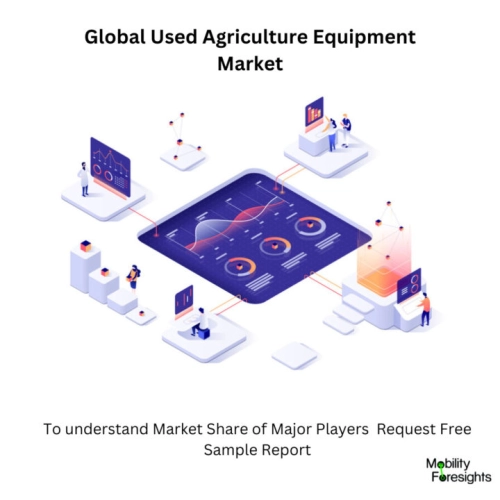
- Get in Touch with Us

Last Updated: Apr 25, 2025 | Study Period: 2023-2030
Agricultural equipment is essential for modern farming operations. It includes machinery, tools, and devices used to cultivate, harvest, and process crops.
This equipment is used to plow, till, plant, and harvest crops, as well as to maintain fields, transport produce, and store harvested goods.
Agricultural machinery also includes equipment used to care for livestock and poultry, such as milking machines, feeders, and shearing tools.
Agricultural equipment has been around since antiquity, when humans first started farming the land. Early equipment was much simpler than the sophisticated machinery used today, and often consisted of manual tools such as scythes and plows.
As technology advanced, so did agricultural equipment, with the invention of the threshing machine in the early 19th century and the combine harvester in the late 19th century.
Today, agricultural equipment is much more advanced, with GPS-enabled tractors, robotic milking machines, and other cutting-edge technology.
Agricultural equipment is essential for the efficient production of food. Farmers must invest in quality equipment in order to maximize their yields and stay competitive in the global market.
The cost of agricultural equipment can be quite high, but many governments offer subsidies and other incentives to help farmers purchase the machinery they need.
Additionally, advancements in technology have made agricultural equipment more efficient and cost-effective. As such, the industry is expected to continue to grow and develop in the coming years.

The Global Used Agriculture Equipment market accounted for $XX Billion in 2022 and is anticipated to reach $XX Billion by 2030, registering a CAGR of XX% from 2023 to 2030.
To further serve its clients, John Deere introduced a number of enhanced agricultural equipment models. It also introduced new technological elements designed to assist farmers in improving their spraying operations.
The wheeled 8R, two-track 8RT, and four-track 8RX models are among the revised 8 Series Tractors from John Deere. One of the technological innovations of the new machines is that the 8R Tractors come with the option of a Central Tyre Inflation System (CTIS).
According to John Deere, it's made to assist farmers cover more ground in a day while also saving time and money. Farmers frequently need to change the tyre pressure while transferring between field and transport operations, and the CTIS is made to make this process quicker and simpler for them.
To modify tyre pressure automatically, operators only need to choose between the "road" and "field" settings. Transport, ride quality, and machine handling are all enhanced by the "road" setting, which raises tyre air pressure to lessen tyre wear.
With a broader footprint and more lug engagement, the "field" setting lowers air pressure to minimise field damage by reducing slip and ground pressure. Operators may easily monitor and change tyre pressure using CTIS, even from the cab, at a rate of up to 2 PSI per minute, just by pressing a button. Any work may be easily adjusted and optimised for inflation pressures with CTIS.
For the 8RX Tractor, a brand-new integrated 1,000 gal. ExactRate Tractor Tank is now available. The business claims farmers may cover up to 80 acres between fills (at 20 gal/acre) when they use it in conjunction with a John Deere planter outfitted with 600 gal. tanks.
As a result, their output is increasing because they are stopping less frequently to refuel. The 8 Series Tractors also come with a number of factory fitted innovations, such as AutoTrac guidance, an integrated StarFire 6000 GPS receiver, and JDLink communication. They are made to assist farmers in getting more work out of their equipment with fewer inputs and less stress, much like other systems on the tractors.
| Sl no | Topic |
| 1 | Market Segmentation |
| 2 | Scope of the report |
| 3 | Abbreviations |
| 4 | Research Methodology |
| 5 | Executive Summary |
| 6 | Introduction |
| 7 | Insights from Industry stakeholders |
| 8 | Cost breakdown of Product by sub-components and average profit margin |
| 9 | Disruptive innovation in the Industry |
| 10 | Technology trends in the Industry |
| 11 | Consumer trends in the industry |
| 12 | Recent Production Milestones |
| 13 | Component Manufacturing in US, EU and China |
| 14 | COVID-19 impact on overall market |
| 15 | COVID-19 impact on Production of components |
| 16 | COVID-19 impact on Point of sale |
| 17 | Market Segmentation, Dynamics and Forecast by Geography, 2023-2030 |
| 18 | Market Segmentation, Dynamics and Forecast by Product Type, 2023-2030 |
| 19 | Market Segmentation, Dynamics and Forecast by Application, 2023-2030 |
| 20 | Market Segmentation, Dynamics and Forecast by End use, 2023-2030 |
| 21 | Product installation rate by OEM, 2023 |
| 22 | Incline/Decline in Average B-2-B selling price in past 5 years |
| 23 | Competition from substitute products |
| 24 | Gross margin and average profitability of suppliers |
| 25 | New product development in past 12 months |
| 26 | M&A in past 12 months |
| 27 | Growth strategy of leading players |
| 28 | Market share of vendors, 2023 |
| 29 | Company Profiles |
| 30 | Unmet needs and opportunity for new suppliers |
| 31 | Conclusion |
| 32 | Appendix |